Data East Arcade 2 Review
More weird, wacky, and wonderful BS from Data East
Data East Arcade 1 is one of my favorite Evercade carts. Always has been. It’s got so many different types of games and all—well most of them are pretty good. It travels with me wherever I bring an Evercade-compatible device.
So I was excited earlier in the year when Blaze announced Data East Arcade 2 was coming out.
As with most Evercade announcements, I had never heard of most of the games before. Indeed I had only ever played Crude Buster before - and then only the Genesis port. But in the trailer I saw…a bunch of weirdo games. I didn’t know if they would be any good, but I knew they would be interesting. And probably a few of them would be fun.
And sure enough….
Peter Pepper’s Ice Cream Factory
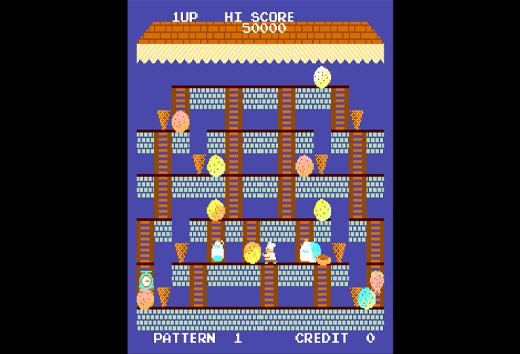
Our good friend Peter Pepper is back! And if you thought thought his first outing in BurgerTime was frustrating - boy, oh boy. Heck, even if you love BurgerTime I like do - boy, oh boy.
As the title implies, Pete has moved on from dinner to dessert. This time rather than dropping burger ingredients onto a plate, you’ll be putting ice cream into cones. Either by dropping it from above or kicking it from below.
You walk around the 8-or-so levels, climbing ladders, outrunning thematically-appropriate sweet foods, and trying to get little scoops of ice cream into their cones. You can push the scoops along platforms, punch them up a level, or kick them down a level. Any junk food you hit with a scoop is temporarily defeated.
Look, this game is frustrating. You move slow, enemies move fast, the enemies are just, like, everywhere, and if you fall off a platform you die. The first few (dozen) times you play it’s going to Feel Bad.
But you'll eventually realize two things that will help you feel like you've got a bit of room to breathe:
- The enemies are pretty dumb.
- You're invincible (and a bit faster) when you're jumping.
Since your main weapon is the very scoops you're trying to stash away, there is an interesting tension here between keeping scoops around to defend yourself vs knocking them into cones to complete the level.
Speaking of knocking them into cones, let's talk about scoring, since arcade games live and die by their scoring systems. I haven't fully groked this yet, but you get points for rolling over an enemy and a little more for hitting one with a kicked scoop. You get points for dropping a scoop in an empty cone and you get more points for adding a second scoop to a cone. There's also an item that appears briefly which grants points and temporarily freezes enemies.
Overall, if you think this sounds too frustrating and like you're not going to like it, you're absolutely right. But if you're one of those sickos who likes banging their head against a game for a while to eventually eke out some minuscule progress…get in line. I can pretty consistently get to the third level, but it’s been a journey.
B-Wings
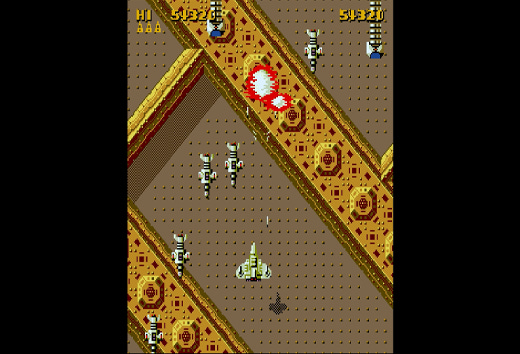
All you need to know about B-Wings is that it's a shoot ‘em up made by Data East in 1984.
That is to say, it has a couple weird ideas that don't fit together quite right, exhaust themselves quickly, and never really gel into a particularly fun experience.
In B-Wings, you pilot a ship that can power itself up with “Wings.” These are different weapons and firing patterns. Wings are distributed sparsely throughout levels, typically with a level giving you access to the exact weapon you need.
Levels are short, with enemies coming at you from every direction. In addition to active enemies, you'll usually find a configuration of obstacles to navigate through or destroy. Typically these obstacles will have a giant glowing weak spot that can be best targeted by the level's Wing, and the enemy attack patterns will also typically match up with the Wing.
Unfortunately, Wings are tough to come by and hold on to. Taking a shot damages your Wing and forces you to jettison it. But there probably won't be another one coming up for a little while.
While without a Wing, you can also dive down to the ground layer of the map for a short time. This allows you to bypass obstacles and dodge projectiles from the layer above, but the ground layer has its own enemies to contend with. As well as lots of walls and other obstacles. So to be honest you probably don't want to spend much time down there anyway unless you need to maneuver around an obstacle to get a killshot on a boss.
Speaking of which, at the end of each level you'll find a boss with one or more glowing weak points you need to hit. And you're also boxed in by a barrage of missiles. Typically with a bit of dodging and timing you can land the few necessary shots without much trouble. Though sometimes having a specific Wing can make it a bit easier.
Mercifully, the levels are short (but frequently brutal) and the bosses very rarely offer any sort of significant challenge. But this is no breezy quick win game, there are a few dozen levels to contend with. Unfortunately, the game seems to run out of ideas fairly quickly, reusing encounters and bosses (or at least near enough that I thought they were identical).
The game is massively one-note visually and any visual distinction offered by the ground layer turns more into noise for you to filter out than something actually interesting to look at.
It's not that this game offers no fun. But on a system like Evercade, if you're looking for a shoot em up to play, this ain't it.
Shoot Out
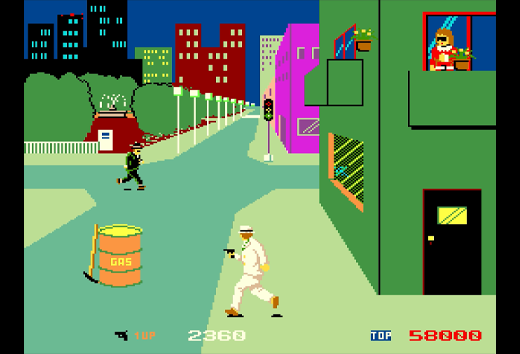
The official genre listed for this game is “third-person shooter,” which is Technically Correct. Wikipedia calls it “Target Shooting,” which is Vaguely Correct. The truth is somewhere in between.
You're a dude in a snazzy, white suit standing at the bottom of the screen. You can walk left and right and you can shoot in 5 directions (forward, sideways, diagonal). You also have a dodge roll that can help you cover more ground and to dodge enemy fire and other hazards.
In each of the levels, a procession of gangsters will appear from around the stage; coming out of buildings, around corners, and out of manholes. You need to shoot these guys before they shoot you. Complicating things are innocent bystanders who are always standing in The Exact Wrong Place or throwing flower pots onto you from balconies. You can also shoot various objects in the scene for bonus points.
I've got to admit I didn't have high hopes for the game. I thought it looked like an interesting curiosity but probably not very fun. On the contrary, though, it's super fun. The movement is a little slow, and it can be tough to keep track of incoming bullets. But the aiming is surprisingly good, the levels are interesting, and it feels good to nail a shot against something falling on your head or to dodge out of the way of enemy fire.
This was a very pleasant surprise.
Last Mission
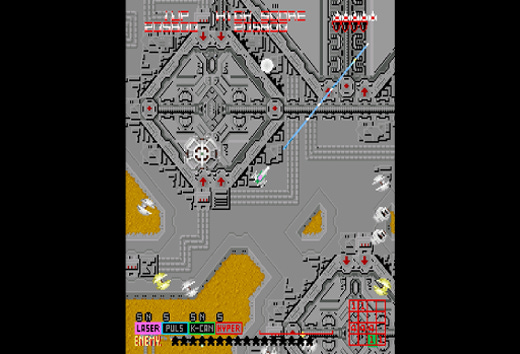
Last Mission is a multi-directional scrolling shooter that offers some neat ideas but never quite lives up to it's potential.
Each level offers a pretty sizeable field to fly your ship around. The level scrolls and wraps both horizontally and vertically. Each level is filled with enemies small and large (I guess the large ones are meant to be bases), as well as other hazards. Destroying enemies fills up a little meter that, when filled, summons the level's boss.
Destroying the larger enemies bases fills a larger portion of the meter, and they drop various power-ups. You can find these bases using the grid map in the lower right of the screen, which shows where you are and how many bases are on a given area of the map.
The power-ups dropped by the bases include additional bombs and alternate weapons that are more effective at dealing with enemies. The alternate weapons are a “Kill Cannon” (a powerful and wide forward shot), “Pulse Cannon” (a three-way shot around your ship), and “Hyper Cannon” (shoots from every direction but forward). Other power-ups, upgrade the range and rate of fire for these weapons. You can also pick up a shield and additional bombs.
Importantly, these weapons only have a set amount of ammo, so you must use the switch weapon button to conserve your more powerful weapons for when you need them. For example, if a bunch of missiles are coming at you from different directions, the Hyper Cannon can pretty easily dispatch them. And the Kill Cannon can help you direct a lot of power in a single direction to deal with bosses.
The moment-to-moment gameplay is hectic and fun, with enemies (and soon other hazards) coming at you from all directions. However, the eight-way movement leaves something to be desired and it can be difficult to line up shots with your basic laser. The weapon management adds an additional layer of strategy, which sits somewhere between interesting gimmick and burdensome complexity.
It's worth noting that if you're playing on the EXP/R with a tate grip, you have no easy way to switch weapons, since that's mapped to Y. While you can play just letting the weapons do whatever they want, you'll soon find yourself wanting to optimize your runs to take them further. And reaching up to hit Y (or R2 if you've remapped to make it smackable) is just awkward. But it plays very well when you have enough buttons available.
Express Raider
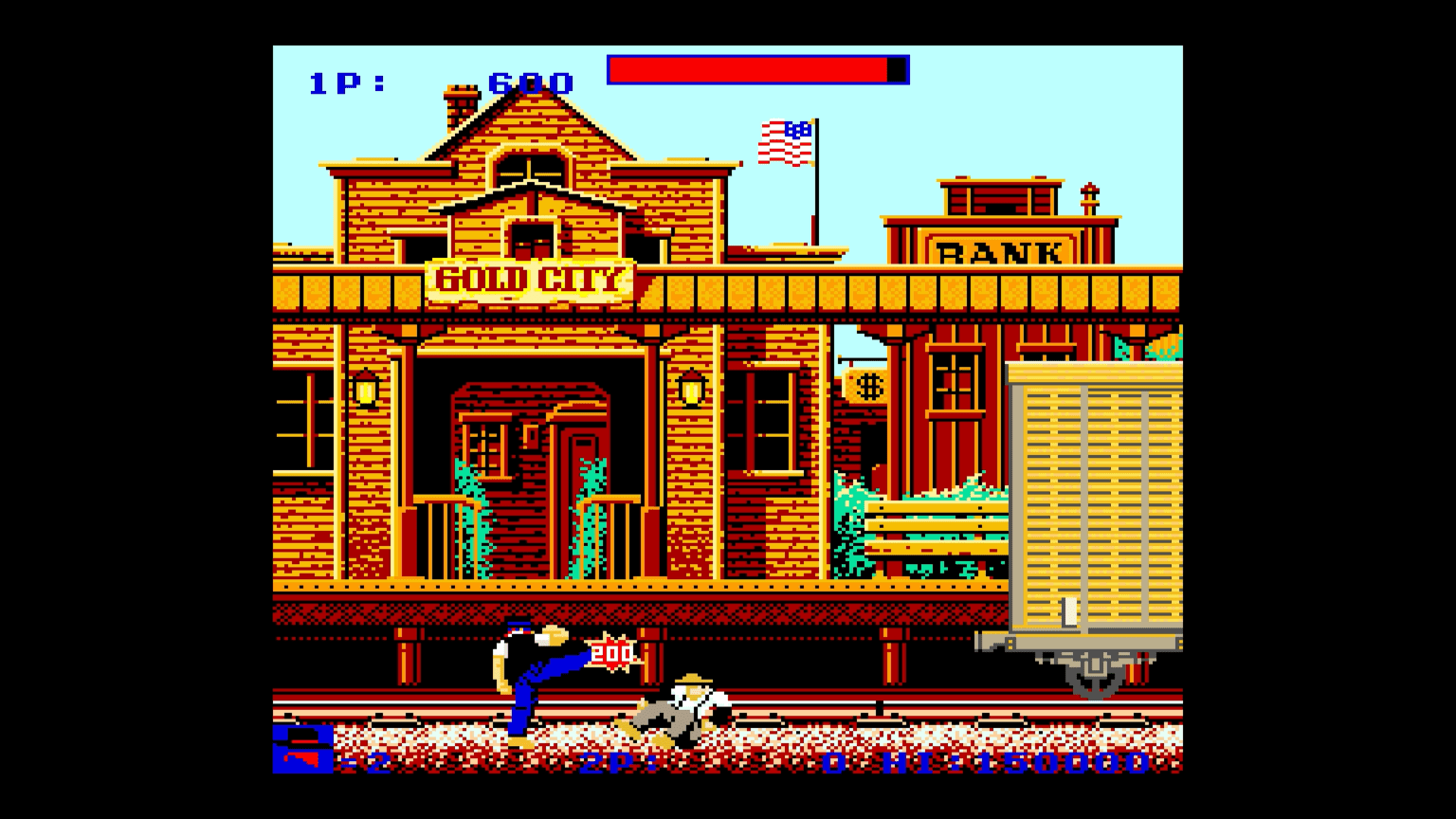
Express Raider was another pleasant surprise for me. Watching the trailer, it looked stiff and janky and weird. That’s not to say that it’s not those things, but it puts all of its pieces together in a very compelling way.
The game takes place across three phases: an on-foot section where you beat up the conductor to board the train (and then punch coyotes for bonus points), another on-foot section where you fight your way across the top of the train to the engine where all of the money is kept for some reason, and an on-horse section where you ride alongside the train to shoot up the train and collect more money.
It’s unclear to me the story connection between the second and third phases. Are you riding away from the train collecting bonuses as you go? I mean, you aren’t boarding another train because that happens when you loop back around to the first phase. I guess it’s maybe not important, cause whatever else it is, it is fun.
You can really feel the age of the game in the on-foot segments. Coming in 1986 (according to The Internet) or 1987 (according to the manual), it feels a lot more like Karate Champ or Urban Champion than Bad Dudes or Double Dragon. And that’s not necessarily a bad thing.
In these segments you fight a single enemy (for the most part) on a single train car. Your health bar resets to 50% each time a new encounter starts and operates as a bit of a tug of war. As you land blows and push the enemy back, the bar goes up. As you get hit and get pushed back yourself, the bar goes down. Eventually, one of you will go toppling off the train and you’ll jump to the next car to do it all over again. As you’re fighting, various hazards may pop up such as low-hanging signs or tunnel entrances you need to duck under. If you take too long on a given car, a bomb will show up on the car coupling. You need to make it to the next car before it explodes and detaches your car or you will lose a life.
The fights themselves are interesting enough - with the variety of moves available to you between jump kicks and lunge punches - but they unfold a little too rapidly and hectically for it to feel like much more than button mashing. Though it’s possible that changes as you become more skilled. Each move yields a different number of points and progress for a given encounter, so you may find yourself jump kicking a coal shoveler versus low punching a guy trying to push you off with a pile of boxes.
I don’t want to forget about the on-horse segments cause those are cool, too. You still make your way car-by-car along the train, but this time you’re riding alongside. As you make your way past a car, people or money bags will pop up and you need to shoot a certain number of enemies to proceed. Enemies will shoot you or throw dynamite, which you simply ride away from or press a button to evade by swinging to the side of your horse. As in Shoot Out, take care not to shoot civilians!
The levels pretty quickly ramp up in difficulty. But if you’re like me you’ll find yourself compelled to try again, convinced that you’ve discovered the proper fighting move to counter the enemy or can be a split-second faster on the evade button to dodge the dynamite.
If nothing else, this game really leans into its theme, and is all the better for it.
SRD: Super Real Darwin
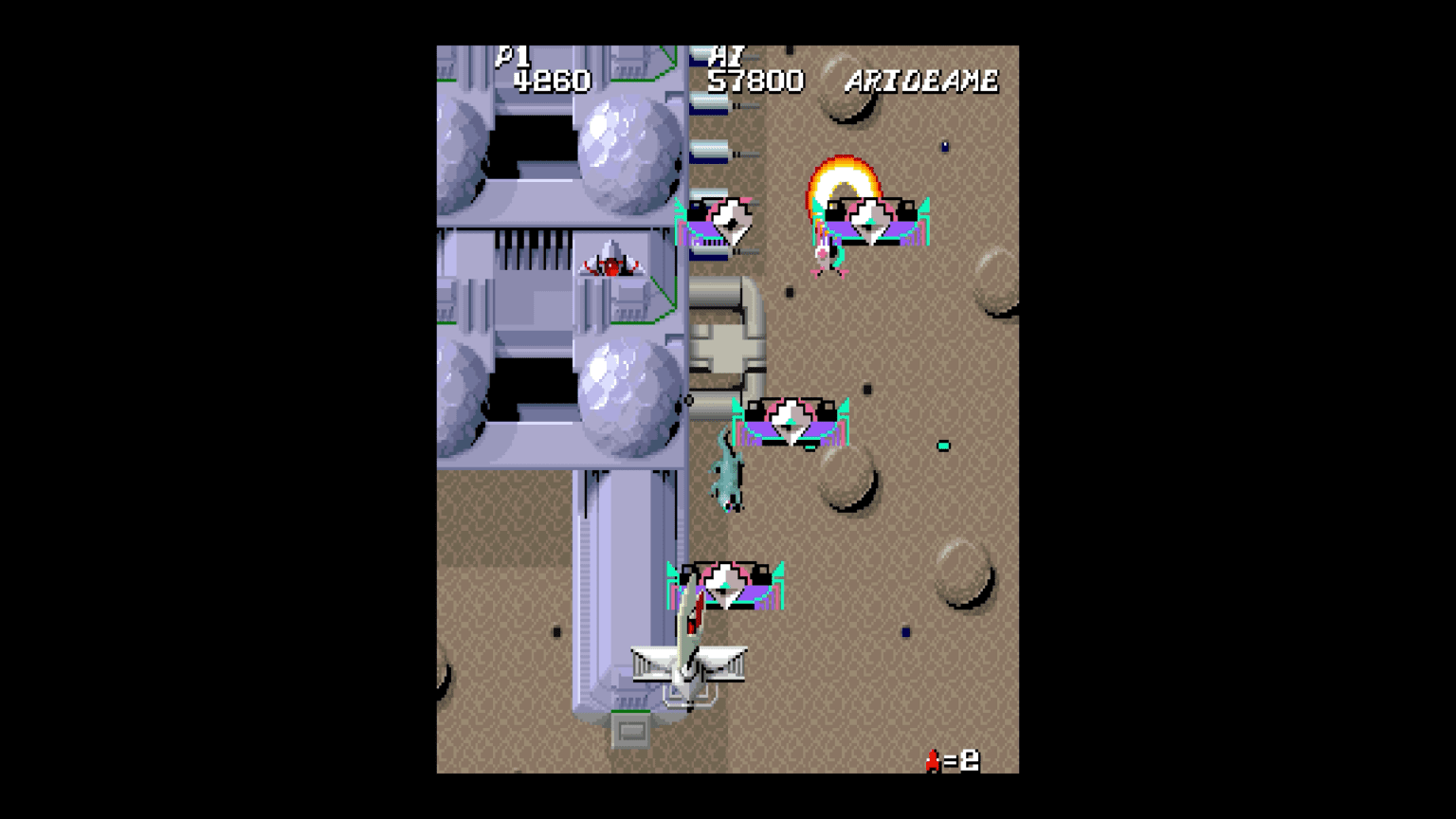
Here we get another close relation to a game from another Data East cart. SRD: Super Real Darwin is the 1987 sequel to Darwin 4078 from the prior year (and Data East Arcade 1).
That’s right, it’s time for more weirdo evolving bio-ship action. With one important difference: It no longer claims you are involved in a crime by playing it outside of the country of Japan.
If you aren’t familiar with its predecessor, Super Real Darwin is a vertical scrolling shoot ‘em up where you fly some kind of evolving ship. Certain enemies will drop “E” capsules, power-ups that cause your ship to evolve into a bigger and more powerful ship. Each evolution has a different name, shape, size, weapon, and firing pattern. If you get shot, you devolve back into the least powerful ship, if you get got then, you die. Crashing into an obstacle or enemy at any evolution level immediately kills you.
There are, like, shield power-ups, too, sometimes. And special E capsules, but let’s keep things simple for now.
In addition to the E capsules, you can also find “DNA” capsules by killing ground enemies with bombs. The number of DNA capsules you have determines how many levels of evolution you get for free after you die. This helps balance the perennial “oops I died and now I’m at a checkpoint and too weak” problem certain shoot ‘em ups have.
Helps, but doesn’t completely solve, anyway. Because you still need to be on your toes to re-collect DNA for the next time you die. If you his a particularly hard section, you’re gonna have a tough time collecting DNA once, much less twice.
But still, this game is a clear improvement over its predecessor. Both from a gameplay standpoint, but also from an artwork standpoint. Darwin 4078 looked, like, fine. Or maybe even good. But it didn’t really work for the game.
In Super Real Darwin, the graphics are a little bit more distinct and a little bit more grounded. It’s a little bit easier to keep track of what’s happening and what everything is. There are still, however, plenty of times where you won’t notice a tiny, stray projectile shot at you from a tiny, stray ground enemy.
In the end, Super Real Darwin is a clear improvement over its predecessor. The core conceit of an evolving ship with wildly different designs and weapons is really cool. And it feels nice to snag a capsule during a tough encounter and suddenly light everyone up.
On the other hand, it feels bad to take a stray bullet in the middle of a fight and stop firing for a couple of seconds while your ship shrinks. And it feels bad to show up at a boss fight without enough evolutions or enough DNA in the bank knowing that you’ve got a game over coming no matter what.
I think this game is fun and interesting, but it’s tough to rate it too high on a platform already drowning in world-class shoot ‘em ups.
Midnight Resistance

You may be familiar with Midnight Resistance from its console port on Data East Collection 1. This game is almost exactly the same, but for minor variations in the levels and different (but not necessarily better or worse) controls. Also you can play 2-player!
If you aren’t already familiar with Midnight Resistance, this is a run and gun arcade game. Think, very loosely, Contra. Deal out the hurt to tons of enemies across the handful of platform-y levels and take on the big ol’ bosses. Levels are pretty intricate, enemy encounters are action-packed but mostly fair, and bosses are pretty exciting.
Throughout the levels, you pick up keys and between levels you can use those keys to purchase upgrades. Alternate weapons like the 3-way spread, “backpack” weapons you can use with up+shoot like homing missiles, a “super-charger” for your main weapon, extra lives, etc, etc.
If you’ve played the console version, you may be familiar with the, uh, interesting control schemes available to you there. The arcade version also suffers from weird controls. Honestly I like these controls better than any of the options on console, but your mileage may vary. In this version, you always face a set direction, no matter which way you’re moving. The twistable joystick has been replaced by the shoulder buttons to cycle you through your eight different facings. It takes some getting used to swinging around like that, but once I got a feel for it, I mostly didn’t have a problem. On the EXP, I found myself often rotating two clicks when I meant for only one, but I didn’t have as many issues with the Alpha or VS controller.
It’s worth noting that - as of this writing - Midnight Resistance currently has save states turned off. Hopefully they can figure out whatever bug save states were causing and they can turn that back on, but the game isn’t super long anyway and pretty easy to credit-feed through.
Crude Buster
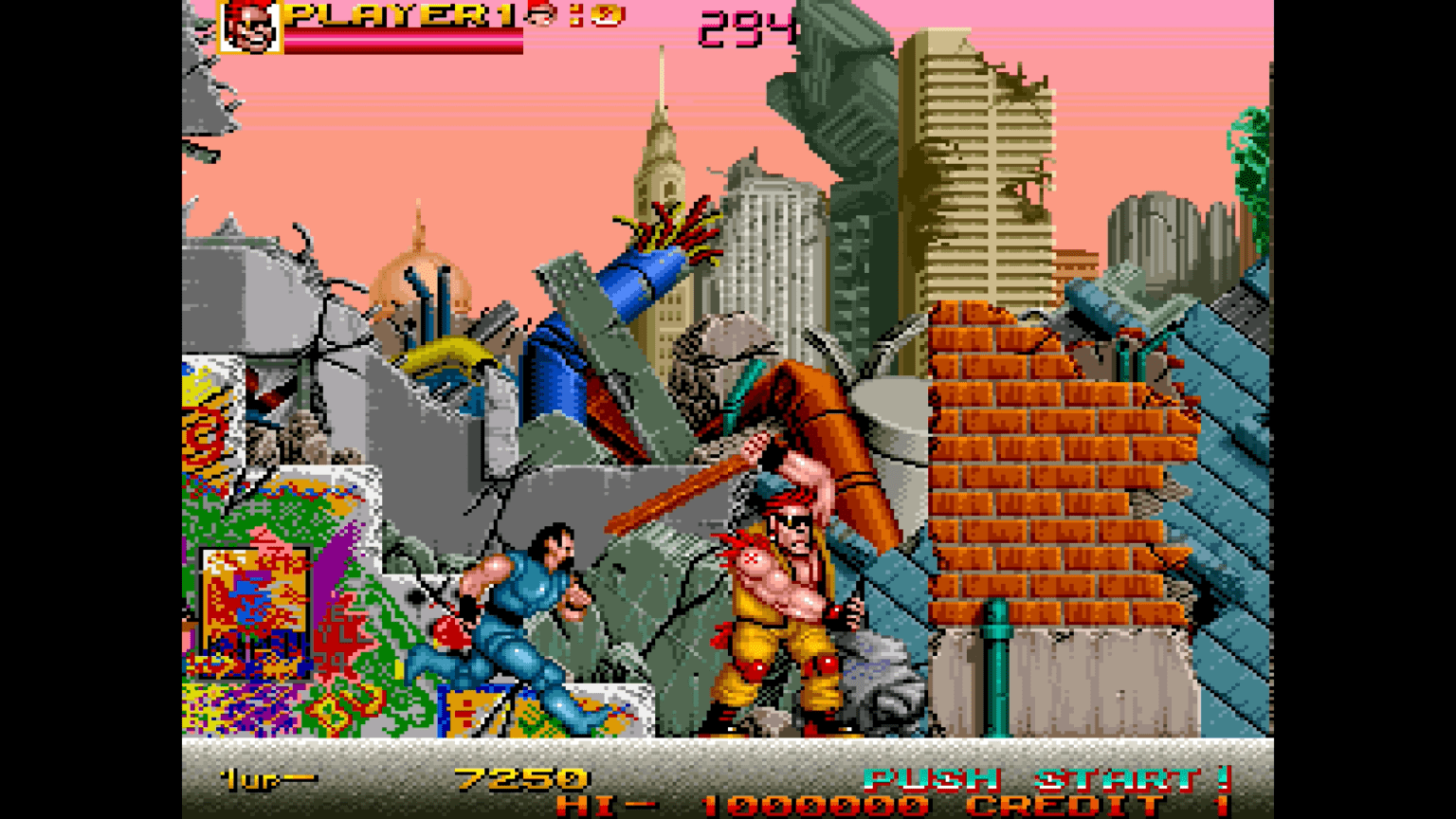
“What a day!” Crude Buster, or Two Crude, or Two Crude Dudes is a colorful (figuratively and literally) beat ‘em up.
You play as one of the eponymous-but-otherwise-nameless Crude Busters, charged with helping The Government retake control of a post-nuclear New York City. Despite your mohawk, tattoos, and tattered vest, it doesn’t sound very punk of you. But alas.
As I mentioned before, this game is colorful, and the sprites are the very definition of “chunky.” And it’s got some pretty funky music to go with it. It’s got a really great vibe going on.
The big gimmick of this game is the ability to pick up rocks, road signs, pipes, electrical cables, cars, and enemies and toss them around. Each screen in the first couple of levels are covered in “Pick Up!!” reminders on all of the items you can interact with. Eventually it stops. Perhaps they figure you’ve gotten the idea.
The game leans way into this idea to the point where boss fights rely on you having a pipe to swing or a sign to throw in order to progress without suffering some of their real cheap attacks.
This game has real character, visually and sonically. And moment-to-moment it plays really well. But the levels tend to be a little too long. Every time I got to a mid-boss I assumed it was the final boss, only to learn I was only halfway there. Which on the one hand is fine, cause it’s more playtime. But it makes the levels feel pretty tedious.
Which is too bad because the levels and the enemies are weird and cool and over-the-top, but the engagement boiling down to “find something to pick up and throw” really limits the experience.
Trio The Punch: Never Forget Me…
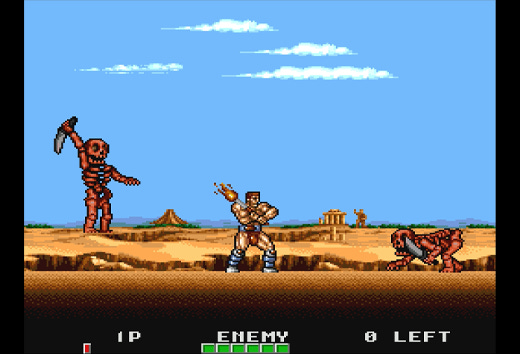
This shit is wild. It’s so difficult to capture in a single image the experience of playing this game.
The manual calls this a beat ‘em up, but that doesn’t even begin to paint the picture. This is a side-scrolling action game that appears to be overflowing with cultural references, references to other Data East games, and bizarre humor. But it’s done with such confidence that it really pulls it off.
You play as one of three characters who all handle and attack slightly differently and make your way through 35 levels. In each level, you must defeat enemies to collect a certain number of heart pick-ups. At which point the boss is summoned. Oh, also in some levels the number of hearts to pick up is zero and the boss spawns immediately.
Bosses include a giant statue of Karnov, a sheep that throws small sheep at you and that turns you into a sheep, and a giant foot.
There’s so much I want to write about this game, but if you’ve played it you already know. And if you haven’t played it, it will sound like the ravings of a madman. This game is not good, but damn is it fun.
Super BurgerTime
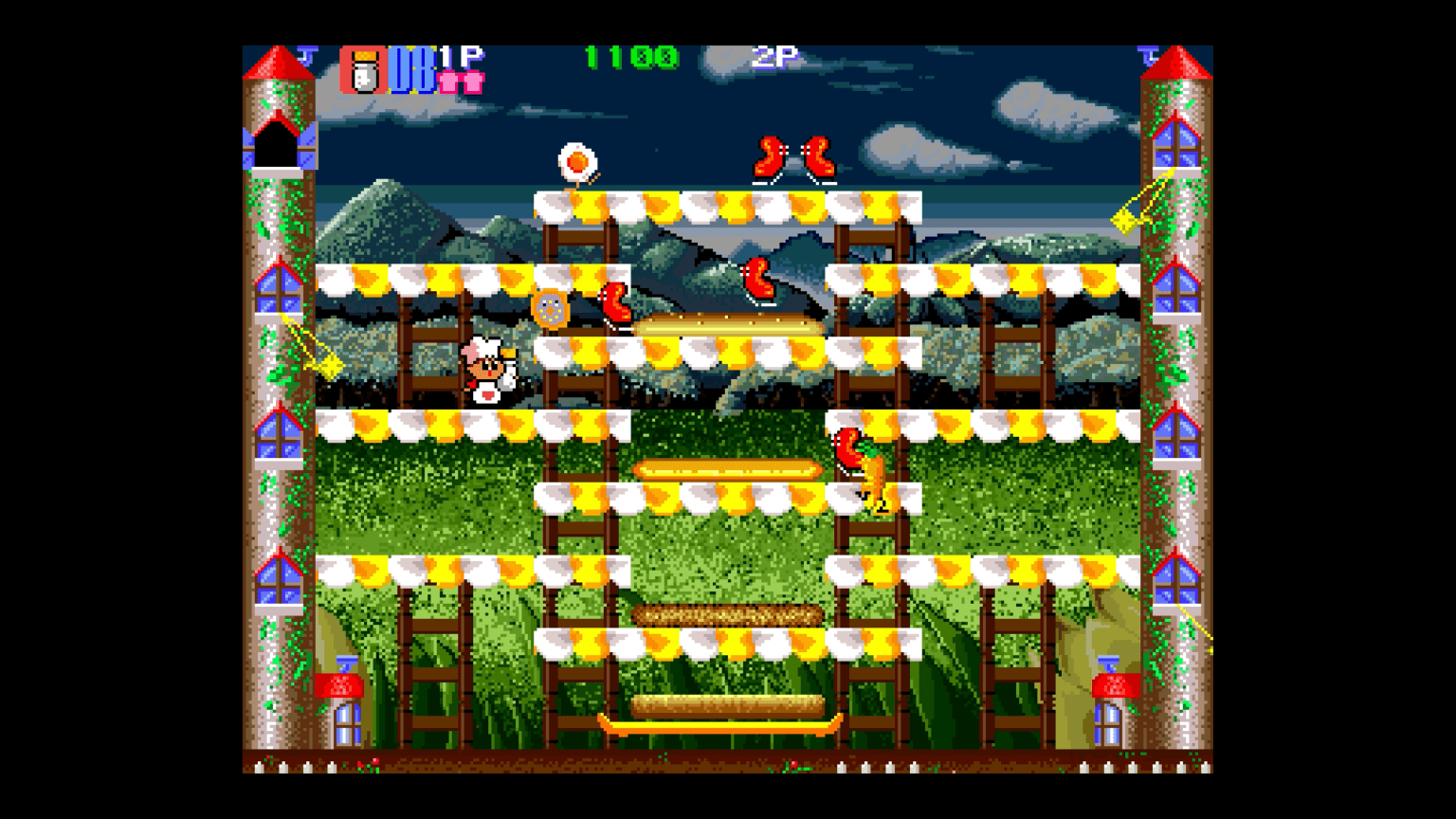
Super BurgerTime is a proper sequel to BurgerTime. You play as Peter Pepper Jr and gotta do the BurgerTime thing - drop all the burger ingredients onto the plates and build some burgers.
As you might imagine, games changed a little bit in the 8 or so years between BurgerTime and Super BurgerTime. Graphics are more detailed, controls are smoother, and the whole presentation a little bit more elaborate.
In Super BurgerTime, you jump on the ingredients to drop them rather than walking across them. You also still have your trusty pepper shaker, but you are no longer limited on the number of shots you can take. You have 30 seconds to use as much pepper as you want. Various power-ups - alternate weapons, speed shoes, stuff like that - will spawn along the side of the level that you can pick up and use in place of pepper.
There are two other major changes here. First, levels are grouped into 5 worlds with 4 levels each, with every 4th level being a boss fight. Second, two players can play simultaneously.
Let’s talk about the bosses. They’re annoying at best and frustrating at worst. The first boss requires very precise spacing and timing to dodge bees flying at you as you try to lob fifteen burgers into their nest. And you better hope you don’t die cause then you’ll lose another life climbing back into position. Oddly, other bosses aren’t nearly as bad. But even so they don’t feel especially BurgerTime. Look at me, gatekeeping.
Overall, though, this game has a lot of charm and is a neat evolution of the BurgerTime formula for the go-go 90s.
Edward Randy
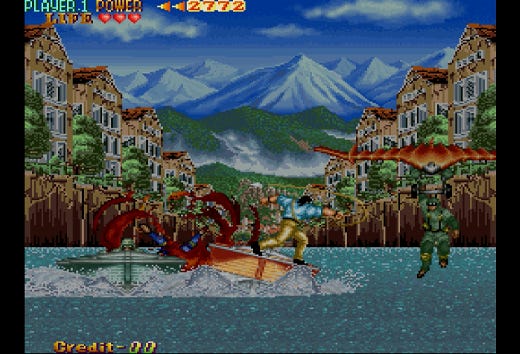
Edward Randy is a very cinematic game, filled with non-stop action.
Each stage unfolds across a constantly shifting, sliding, and scaling set of boats, jeeps, platforms, and biplanes, barely even taking a break at the end of each stage before thrusting you into the action of the next one.
Vehicles plummet off cliffs, soldiers are thrown into foreground, and bosses literally explode across the screen. It looks incredible.
Through it all, you, Edward Randy, use your trusty but legally-distinct whip to dispatch your enemies and swing around the stage from grapple points. Unfortunately, you’ll often find yourself doing one thing when you mean to be doing the other.
Despite the fluid and frenetic action unfolding on the screen, the controls are stiff and the context-sensitive actions often give you the wrong result. You’ll mean to be whipping upwards to knock some enemies off the truck, but instead find yourself grappling to a rail and swinging over to another truck that’s just about the leave the screen.
It can be pretty frustrating. But, damn, when it works it works.
One other curiosity worth mentioning is the energy system, which is tied to your score for some reason in a constant tug-of-war not unlike Express Raider. As you defeat enemies, your score increases. As you take damage, your score decreases. And as near as I can tell, your submission to the scoreboard ends up being the highest score you accumulated before you reached zero.
But, really, it hardly matters. Cause if you’re playing this game for such petty things as “numbers,” you’re missing the point.
Joe & Mac Returns
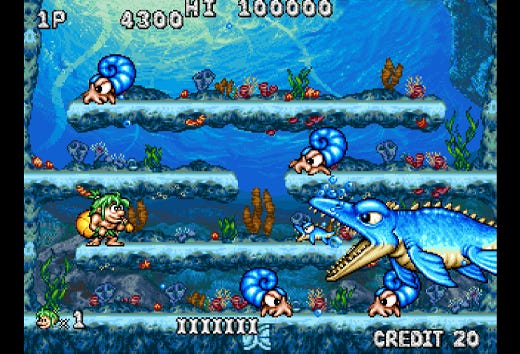
I love single-screen platformers. Specifically, I love elimination platformers. They’re fun, fast-paced, accessible, and I can get my wife to play multiplayer with me.
Tumblepop, on Data East Arcade 1, is one of my favorites. And Joe & Mac Returns paints right inside those same lines. It doesn’t do anything especially new or exciting, but it looks great, sounds good, plays well, and…yeah, it’s basically Caveman Tumblepop. Nothing wrong with that.
In Joe & Mac Returns, you play as…Joe or Mac. You’ve got a club you can use to stun the various animals and enemy cavemen wandering around the levels, touching a stunned enemy puts them in your bag, when you can throw the bag to defeat other enemies. The more enemies in your bag, the more other enemies you can roll over. Defeated enemies drop pick-ups for points or upgrades like a better club or speed skates.
Also in each level are captured cavewomen who you can rescue for even more pick-ups. Each world ends with a fight against a boss, where you need to collect small enemies to throw at a big enemy.
After each boss you get a little cutscene where Joe and Mac perv out on cavewoman then move on to the next world.
This game is good and fun. I have no problems with it. However, it’s worth mentioning that it doesn’t really do anything different than Tumblepop
Wrap-Up
Look, I love this cart. It’s all the variety I loved about Data East Arcade 1 but with the weirdness dialed all the way up.
These games are, by turns, weird, experimental, or evolutionary dead-ends. I consider all of these games “fun” to some degree, but there’s only a single game - Joe & Mac Returns - that I can classify as “good” without any qualifications.
You can find better shoot ‘em ups on no less than 5 different carts. Better beat ‘em ups, too, on a few. Run and guns? You guessed it. Single-screen platformers? That, too. Heck, even third-person shooters while we’re at it.
What you’re left with, though, is a bunch of games stuffed full of creativity and heart. If you’re down to get weird, I can’t recommend this cart highly enough. But if you’re a little bit more straitlaced with your gaming preferences or are looking for only the highest quality experiences? Well…
Though it pains me to say, you should only Consider getting this cart. You may be better off spending your money on a Toaplan or Data East Arcade 1.
Also feel free to subscribe, if you want. In case I decide to publish more of these. No pressure, but Substack is pretty insistent that I add this button for you so I’m complying. Engagement and all that.